 “I’m old enough to be your mother!”
“I’m old enough to be your mother!”
Think about the last time somebody at work said this to you.
How did it make you feel?
Young?
Annoyed?
Insecure?
Unsuccessful?
Ready to jump out the window?
Probably all of the above. As someone who hears this comment on a daily basis, I know how you feel. It’s tough being the youngest person in the office, isn’t it?
But that’s the reality. According to a recent USA TODAY article, Generation Y is a force of as many as seventy million people taking their place in an increasingly multi-generational workplace.
“This age group is moving into the labor force during a time of major demographic change, as companies around the USA face an aging workforce.”
“Sixty-year-olds are working beside 20-year-olds. Freshly minted college graduates are overseeing employees old enough to be their parents. And new job entrants are changing careers faster than college students change their majors, creating frustration for employers struggling to retain and recruit talented high-performers.”
THE QUESTION IS: How are you supposed to be taken seriously when you’re the youngest person in the room?
SHORT ANSWER: Being proactive and powerful without coming off as arrogant and annoying.
LONG ANSWER: Today I’m going to teach you exactly how to do that.And please note, what you’re about to read is not another rapid-fire list of simplistic, superficial pseudo-advice that any schmuck with more than two weeks of job experience could tell you.
In fact, we should probably just get that stuff out of the way now:
Exude powerful body language. Dress for success. Avoid spelling errors. Show up to work on time. Don’t photocopy your ass during business hours. Articulate your words clearly. Smile – but not too often. Have a firm handshake. Respect your elders. Remove your spiked dog collar before meeting with the company president. Blah. Blah. Blah.
Okay, I feel better. Now we can get cracking on the ideas that matter. Here’s a compendium of practices and strategies to be taken seriously by people twice your age:
1. Take seriously the things that matter. If you want people twice your age to take you seriously, the first step is to stop taking yourself so seriously. Obviously, not at the expense of respect or professionalism. Becoming a poster boy for apathy rarely gets you anywhere.
Instead, the secret is pinpointing the non-negotiable values in your life that are worth taking seriously – health, job, career, family, growth, honesty, whatever – then making sure your behavior reinforces that constitution.
That’s what people notice. That’s what people remember. That’s what people respect. Someone with enough strength to be simultaneously self-effacing and self-confident.
And admittedly, as a young professional, this is a difficult balance to strike. When you’re working tirelessly to make a name for yourself, it’s easy to get snared into the seductive trap of self-importance.
Ultimately, if you truly want people to take you seriously, don’t just get over yourself – stay over yourself. How are you educating yourself in the language of humility?
2. Make the invisible inescapable. After a recent speech in Melbourne, I stopped by the city art museum to see the Titanic exhibition. Other than the replicated iceberg you could touch (so cool!) the most powerful moment of the tour was walking through the Crew Room.
We explored dozens of bios and portraits of these beefy, diligent, hardworking men – seventy-five percent of whom went down with the ship. And I learned that they shoveled 825 tons of coal a day.
That’s over a million and a half pounds. And above the memorial of the crewmembers that perished in the crash, the epitaph read:
“The task is vital, the labor is invisible and the work is an endless cycle.”
What about you? What percentage of your work is unseen by the masses?
If you want to get people to take you seriously, here’s my suggestion: Make your invisible work inescapable to the people who matter. Otherwise all your time and toil will go unnoticed. What vital tasks are you turning into viral videos?
3. Perspective is the rein and rudder. That was Leo da Vinci’s philosophy. And whether you’re working on a painting or in project management, the same principle of perspective applies.
Take my cousin, Avery, for example. He’s fourteen. Recently, he said something that completely blew the lid off my brain. During family dinner one Sunday, I asked him to email me the name of a particular video game he mentioned.
And I swear to God – you can’t make this stuff up – here’s what came out of his mouth:
“Email? That takes forever!”
Talk about perspective. I couldn’t believe my ears. But Avery’s comment was spot-on. Apparently, people under the age of twenty don’t email. Takes too long. They text, instant message or use Facebook. That’s how they communicate. Email is the new snail mail. Unbelievable. And all Avery did was say a few words.
Lesson learned: The ability to deliver powerful perspective wrapped in a concise package, to the right people, at the right time, is priceless. More often than not, simile is the perfect tool for doing so.
For example, whenever I want to make a point about the increasing irrelevancy of libraries, I’ll say, “A library? Is that like Netflix for books?” As much as it pains me as an author to say that, it usually drives home the perspective pretty well. What drives yours?
4. Craft a sincere story regarding your journey – then broadcast it. First, take some time to physically write out your unique story:
*What crucial decisions changed everything?
*What questions did you ask yourself along the way?
*How many times did you stumble?
*Who was there to help you dust off your pants?
These are the things that matter.
Second, represent this story three-dimensionally. Write it out. Share pictures. Tell the story on video. Whatever medium works for you.
Finally, connect with as many media outlets – mainstream or amateur – to broadcast that story with the world. Because when everybody knows your story, you win. Just as long as your story is engaging, remarkable and relevant.
Remember: When people understand where you came from, they’re more likely to believe in where you’re going. Do decision makers know your story?
5. Present what you do as a legitimate source of income. Money attracts attention. Period. I’m not saying it’s the most important thing in the world, but there is a direct relationship between profitability and legitimacy. Especially when barriers to entry continue to crumble.
Anyone can start a company. The question is: How much revenue is actually coming in?
Anyone can become an expert. The question is: What profit centers are you converting your expertise into?
Anyone can build a following. The question is: How are you converting followers into dollars?
If you can’t spit out (somewhat) quantitative answers to these questions, you lose. Your goal is to reveal enough financial evidence of your success that people nod their heads in approbation; but not so much that they tilt their heads in aggravation.
I remember the first time I experience the power of this strategy. It was 2005, and my company was just starting to turn a profit. During a television interview, the news anchor casually mentioned that I had converted the idea of wearing a nametag into six-figure enterprise.
I didn’t ask him to say that, he just did. And wouldn’t you know it? That was the one part of the interview that everyone commented on. Huh. I guess money really does lend itself (rim shot) to credibility. How are you reinforcing you economical legitimacy?
6. Enthusiasm is a gift – use it while you can. Last night I met the owner of a local cheese company. Intrigued, I asked him, “What does someone’s favorite cheese say about her personality?”
For the next ten minutes, our table listened to Adam rant enthusiastically about all things cheesy. From manufacturing to cooking to milking the goats correctly, it was quite possibly the most fascinating conversation I’ve had in six months. Even the people at our table – twice his age – were engaged with rapt interest.
Do you think they’ll take him seriously next time they throw a wine and cheese party? Absolutely.
Lesson learned: Never underestimate the power of enthusiasm. As a young professional, your energy is your greatest asset – use it. Every day. Speak with passion or risk being unheard.
Just remember two caveats: First, be careful not to overdo it. People can’t take you seriously if they’re too busy trying to figure out it what brand of crack you’ve been smoking.
Secondly, be sure to match enthusiasm with accuracy. If your energy isn’t supported with truthfulness, you’re nothing but a passionate incompetent. How are you leveraging your youthful energy?
7. Monitor the consistency of your virtual personality. The Internet is forever. Everything matters, everybody’s watching and everything’s a performance. Which, isn’t that hard to do if the character you’re playing is you.
So, for the love of Google, be careful what you share with the world. If your online performance isn’t an accurate mirror of your offline reality, you lose. And don’t act like it could never happen to you. Self-incrimination is an easy mistake made by smart people every day.
And the danger is: It’s cumulative. Which means the more often you do it – that is, the more often you position yourself online in a negative light – the less likely people are to take you seriously.
“You know, Julie made a good point during today’s meeting,” the boss says. “Then again, Julie’s status update from last night says she pounded fifteen shots of Jäger in thirty minutes. No wonder she puked into the paper shredder this morning.”
Lesson learned: Avoid sloppy mistakes that make rejecting you easy. Be careful what you publish. Do you want to become known for what you’re about to post?”
8. Replace bitching with evidence. Yes, it’s frustrating to work at an office primarily populated by people who grew up on vinyl and Vietnam. And it’s even more frustrating when those people don’t take you seriously.
But don’t default to shedding tears just to prove your salt. Instead, focus on sharing tangible proof. When you have a problem, complaint or issue, calmly present your issue to the powers that be in a quantitative, organized, legitimate and nuts and bolts fashion.
That’s the type of presentation style that older generations respond to. Plus, by pressing the off button on the water works, you avoid getting lumped into stereotype of being a whiner.
This brings me to Psychology Today, which published an article in the May 2010 issue called, Generation Y or Generation Whine?
According to the piece, those born between 1982 and 2002 are turning the country into a nation of wimps. “Entitled, spoiled, whiney and unable to take criticism,” are just a few of the other terms used to describe my generation.
Obviously, this is a gross generalization. Unfortunately, this isn’t the only publication spouting such stereotypes. It seems like every week you come across another magazine or newspaper spreading similar stories.
As such, do whatever you can to prevent putting yourself in that category. Bitching isn’t the answer – evidence is. How much of it is your case presenting?
9. Show massive gratitude to the people who took risks on you. Success never comes unassisted. Ever. If you’re lucky enough to find a champion, somebody to go to bat for you – thank her sincerely. If possible, in person.
Here’s what you do: Take her aside, look her straight in the eye and say:
“Julie, you put your ass on the line for me, and want you to know how much I appreciate it. Thanks for believing in me. You support was essential, and I wouldn’t be here without you. I promise to keep you updated with my progress.”
But it doesn’t end there. Gratitude is isn’t just a few honest words – it’s a calendar of consistent action. And it functions as a thank you in perpetuity to the people who took personal and professional risks to help underwrite your success. Who did you thank yesterday?
10. Wear your commitment like an iron skin. As a Gen-Xer, I come from a commitment-averse generation. Here’s why:
Because of our instant gratification culture, we’re impatient.
Because of our privileged upbringing, we developed a mediocre work ethic.
Because of our self-reliant, entrepreneurial bent, we don’t offer loyalty easily.
Because of our abundance of choices, we’re quick to quit and pursue something better.
No wonder we can’t stick with anything for very long. From college majors to new jobs to romantic relationships, stick-to-itiveness isn’t exactly our forte.
For that reason, stick-to-itiveness is a non-negotiable pre-requisite for being taken seriously. What’s more, commitment isn’t something you do – it’s something you are. You don’t need to get a nametag tattooed on your chest like I did.
But you do need to memorialize your commitment and stand proud to the general gaze of the world. That’s the tricky part. That whole “every day” thing. Because while it takes guts to stick yourself out there – it takes gusto to keep yourself out there. How do you wear your commitment?
11. Show people that you aren’t going away. Reliable. Predictable. Dependable. Consistent. That’s the big-picture secret to being taken seriously: Making sure your actions provide people with irrefutable proof that you’re in it for the long haul.
That’s one of the reasons I publish so many books. Not just because writing is my religion. Not just because I have volumes to say. And not just because books are extremely profitable for my business.
But also because with every new book that comes out, I reinforce to people that I’m not going away.
That I’m not just another a one-hit-wonder, flash-in-the-pan bullshit artist. Like comedy legend George Carlin, your challenge is to show people that your “prime” will last for forty years. That should perk people’s ears up. What are you doing to last?
REMEMBER: Being taken seriously is serious business.
Your generation isn’t the future of the workforce – it’s the present.
If you want to be taken seriously by people twice your age, commit to implementing these strategies on a daily basis.
That way, next time Phyllis from accounting grumbles, “I’m old enough to be your mother!” you can just look at her with confidence and say, “What’s your point?”
LET ME ASK YA THIS…
How many opportunities did you lose because people didn’t take you seriously?
LET ME SUGGEST THIS…
For the list called, “65 Things I Wish Somebody Would Have Told Me When I Started My Company,” send an email to me, and you win the list for free!
* * * *
Scott Ginsberg
That Guy with the Nametag
Author, Speaker, Entrepreneur, Mentor
[email protected]
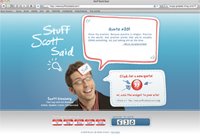 Who’s quoting YOU?
Who’s quoting YOU?
Check out Scott’s Online Quotation Database for a bite-sized education on branding success!
www.stuffscottsaid.com.
 “Ideas are free; execution is priceless.”
“Ideas are free; execution is priceless.”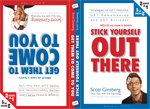 The world’s FIRST two-in-one, flip-flop book!
The world’s FIRST two-in-one, flip-flop book!
 “Damn it! Now why didn’t I think of that?”
“Damn it! Now why didn’t I think of that?”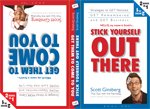 The world’s FIRST two-in-one, flip-flop book!
The world’s FIRST two-in-one, flip-flop book! Sometimes, it sucks being the youngest one in room.
Sometimes, it sucks being the youngest one in room.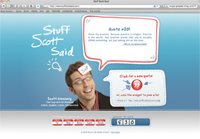 Who’s quoting YOU?
Who’s quoting YOU? This is all Google’s fault.
This is all Google’s fault.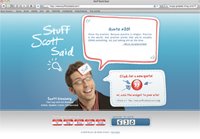 Who’s quoting YOU?
Who’s quoting YOU? “I’m old enough to be your mother!”
“I’m old enough to be your mother!” Who’s quoting YOU?
Who’s quoting YOU? Years don’t make you wise.
Years don’t make you wise. Who’s quoting YOU?
Who’s quoting YOU? “What scares you?”
“What scares you?” Who’s quoting YOU?
Who’s quoting YOU? “What scares you?”
“What scares you?”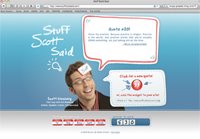 Who’s quoting YOU?
Who’s quoting YOU? After an hour of deliberation, I couldn’t come up with a clever way to start this blog post.
After an hour of deliberation, I couldn’t come up with a clever way to start this blog post. Who’s quoting YOU?
Who’s quoting YOU? Imagine you’re a California prospector panning for gold in 1852.
Imagine you’re a California prospector panning for gold in 1852. Who’s quoting YOU?
Who’s quoting YOU?